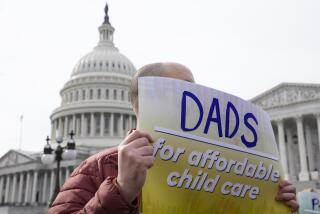Health Funds Good News for Kids
- Share via
WASHINGTON — In the largest expansion of health care for children since Medicaid’s creation in 1965, Uncle Sam is about to hand the states $24 billion to cover up to half of America’s 10-million uninsured kids. But most states are already a step or two ahead of Washington.
Using a variety of approaches, most notably broadening Medicaid eligibility, nearly every state, including California, has extended coverage to children of working but low-income families in recent years.
That collective effort is a largely unrecognized, if modest, success story: Even as the ranks of uninsured adults continue to swell inexorably, the number of uninsured children has remained stable, with about one in seven lacking coverage.
The impending flow of federal largess to the states over the next five years--part of the budget bill approved by Congress--means millions of children will enjoy medical insurance, many for the first time in their lives. The children’s health care coverage is to be financed in part by an increase in the federal cigarette tax.
And while a dispute persists over just how many children will receive meaningful coverage, the expansion in health care was hailed by children’s advocates as well as the nation’s governors, who will be charged with devising ways to reach the uninsured children.
“This historic investment in children’s health is a major victory for America’s children and working families,” said Marian Wright Edelman, president of Children’s Defense Fund.
“This is cause for some serious celebration,” said Dr. Irwin Redlener, a New York physician and longtime children’s advocate.
Nevada Democratic Gov. Robert Miller and Ohio Republican Gov. George Voinovich, meeting in Las Vegas recently for the National Governors’ Assn. conference, praised Congress and President Clinton for “giving [state officials] the ability to build on their successes in designing health insurance programs that meet the unique needs of their states.”
*
The enthusiasm of children’s advocates, however, was tempered by the realization that the few-strings-attached block grants to the states will result in a hodgepodge of programs with different eligibility standards and varying benefits packages--depending on the state in which a child lives and possibly the region within the state.
Children’s advocates also fear the “substitution effect”--the likelihood that at least some employers will stop covering their workers’ dependents after new health care programs for children are created.
But such “crowding out” is likely to be minimal because most low-paying jobs do not come with health insurance as a fringe benefit in the first place, argued Sen. John D. “Jay” Rockefeller IV (D-W. Va.), another champion of children’s health care.
“We want every child in America to grow up healthy and strong, and this investment takes a major step toward that goal,” Clinton declared after the budget agreement was announced last week.
“By investing fully $24 billion, we will be able to provide quality medical care for these children, everything from regular checkups to major surgery,” he added. The president asserted that “up to 5 million” uninsured children will get coverage.
States face a limited range of options in extending health care to uninsured children--the foremost being the expansion of Medicaid eligibility, although that seems an unlikely route this time for most states.
In the 32 years since Medicaid was created, 39 states, including California, have significantly expanded eligibility for pregnant women and children beyond federal requirements. Between 1989 and 1993, for instance, 5 million children were brought into Medicaid, a joint federal-state health- insurance program for certain categories of the indigent.
In all, 34.2 million people, about half of them children, are enrolled in Medicaid.
*
Most states have extended coverage to uninsured children by expanding Medicaid in part because the program provides comprehensive benefits and relies on existing administrative and reimbursement systems. But this option has proven costly for the states.
That is why governors have increasingly sought greater leeway in setting benefits packages--a demand that emerged in bold relief during the recent budget talks.
That desire for greater flexibility is precisely what has prompted many states to extend coverage to children, not by expanding Medicaid but by using their own funds to contract with managed-care providers to deliver services directly to children who are ineligible for Medicaid, either because of age or family income.
Such arrangements allow states to avoid the array of federal mandates that come with Medicaid, thus allowing states, for example, to offer a limited benefits package and even to require co-payments and premiums, based on a sliding scale. In addition, such flexibility allows states to test pilot programs that involve as small an area as a county, health care experts said.
*
Still another benefit of the non-Medicaid approach is that it is easier to enroll children in a program that does not carry the social stigma some attach to Medicaid. (About 3 million uninsured, Medicaid-eligible kids are not enrolled in the program.)
Among the most successful of such approaches are the Florida Healthy Kids program, which uses schools as the administrative base, and the Massachusetts Children’s Medical Security Plan, which provides preventive care to children younger than 19.
Even so, Healthy Kids covers only 18,000 kids, leaving 655,000 Florida children still uninsured, according to the National Conference of State Legislatures. Similarly, the Children’s Medical Security Plan covers only 27,000 kids, leaving some 126,000 Massachusetts children uncovered.
A third option for the states is the creation of private-public initiatives patterned after the Caring Programs for Children, charitable foundations set up by Blue Cross-Blue Shield Assns. in 24 states. Some states contribute their own funds to the programs, which have a combined enrollment of 60,000 kids.
A fourth option states have is to use block-grant funds to provide direct health services, such as immunizations and well-child care. But the budget agreement forbids states to use more than 10% of such funds for noncoverage purposes--a clause demanded by those who feared that financially strapped states would use the money for unrelated purposes.
Times political writer Ronald Brownstein contributed to this story.
More to Read
Sign up for Essential California
The most important California stories and recommendations in your inbox every morning.
You may occasionally receive promotional content from the Los Angeles Times.










